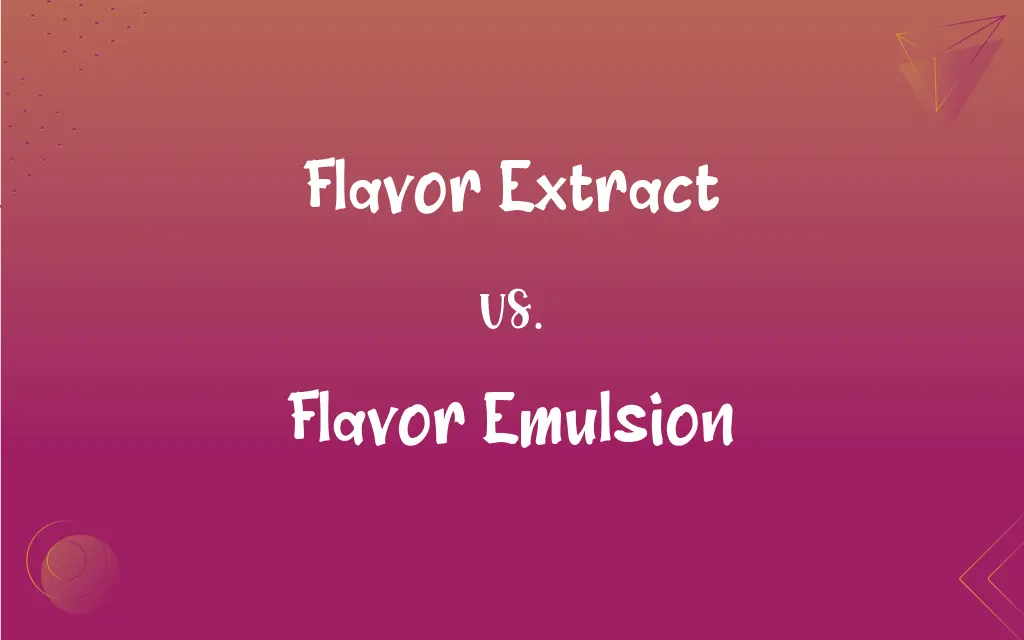Flavor Extract vs. Flavor Emulsion: What's the Difference?
Edited by Harlon Moss || By Janet White || Published on March 27, 2024
A flavor extract is a concentrated solution made by extracting the flavor compounds from natural ingredients, typically using alcohol. A flavor emulsion is a mixture of flavor oils dispersed in water with the aid of an emulsifying agent.

Key Differences
Flavor extracts are created by soaking natural ingredients, such as vanilla beans or citrus peels, in alcohol to draw out their essential oils and flavors. This process results in a concentrated liquid that can be used in small amounts to add flavor to food and beverages. Flavor emulsions, on the other hand, are made by dispersing flavor oils in water with the help of an emulsifier, creating a stable mixture that can be used in various culinary applications.
The alcohol base in flavor extracts not only helps extract flavors but also acts as a preservative, extending the shelf life of the product. In contrast, flavor emulsions are water-based and may require additional preservatives to maintain their stability and prevent spoilage. The emulsifying agents in flavor emulsions ensure that the oil and water components do not separate over time.
Flavor extracts are often used in baking and cooking where the alcohol content can evaporate during the cooking process, leaving behind the desired flavor. Flavor emulsions are particularly useful in applications where the addition of alcohol is undesirable, such as in non-alcoholic beverages, frostings, and certain baked goods where the alcohol may not fully evaporate.
One of the advantages of flavor emulsions is their ability to retain flavor in high-heat applications, as the emulsion process protects the flavor compounds from evaporating. This makes them ideal for use in products that require baking or exposure to high temperatures. Flavor extracts, while versatile, may lose some of their potency when exposed to heat.
Both flavor extracts and flavor emulsions are used to impart flavor to food and beverages, but they differ in their composition, production methods, and applications. Flavor extracts are alcohol-based and suitable for a wide range of culinary uses, while flavor emulsions are water-based and excel in high-heat applications where alcohol evaporation is a concern.
ADVERTISEMENT
Comparison Chart
Base
Alcohol-based
Water-based with emulsifying agents
Production Method
Extraction of flavors from natural ingredients
Dispersion of flavor oils in water
Alcohol Content
Contains alcohol
Alcohol-free
Heat Stability
May lose potency when exposed to heat
Retains flavor in high-heat applications
Applications
Versatile, used in baking, cooking, and beverages
Ideal for non-alcoholic beverages, frostings, and baked goods
ADVERTISEMENT
Flavor Extract and Flavor Emulsion Definitions
Flavor Extract
A flavor extract is a concentrated solution obtained by extracting essential oils and flavors from natural ingredients using alcohol.
Vanilla flavor extract is a popular ingredient in baking recipes.
Flavor Emulsion
Flavor emulsions are often used in the food industry for flavoring beverages, confectionery, and baked goods.
A bakery might use a lemon flavor emulsion to add a zesty taste to lemon poppy seed muffins.
Flavor Extract
Flavor extracts are used to impart specific tastes to food and beverages without adding the actual ingredient.
Lemon flavor extract can be used to add a citrusy taste to cakes without using fresh lemons.
Flavor Emulsion
A flavor emulsion provides a uniform distribution of flavor in the final product, ensuring consistency in taste.
Strawberry flavor emulsion is used in ice creams to ensure a consistent berry flavor throughout.
Flavor Extract
A flavor extract is a versatile culinary ingredient that enhances the flavor profile of a wide range of dishes.
A few drops of almond flavor extract can enhance the taste of marzipan and other sweets.
Flavor Emulsion
Flavor emulsions can be created from a wide range of flavors, including fruity, savory, and sweet profiles.
Maple flavor emulsion is a popular choice for adding a sweet and distinctive flavor to pancakes and waffles.
Flavor Extract
Flavor extracts can be made from various natural sources, including fruits, herbs, and spices.
Cinnamon flavor extract is commonly used in baking to add warmth and spice to desserts.
Flavor Emulsion
A flavor emulsion is a stable mixture of flavor oils dispersed in water with the help of an emulsifying agent.
Orange flavor emulsion is often used in soft drinks to provide a consistent citrus taste.
Flavor Extract
Flavor extracts are typically used in small quantities due to their concentrated nature.
Only a teaspoon of peppermint flavor extract is needed to flavor a batch of chocolate chip cookies.
Flavor Emulsion
Flavor emulsions are ideal for applications where the addition of alcohol is undesirable or where heat stability is required.
Butter flavor emulsion is commonly used in frosting recipes to maintain a rich flavor during baking.
FAQs
Can flavor extracts be used in place of flavor emulsions?
While they can sometimes be used interchangeably, extracts and emulsions have different properties and applications, so it's important to choose the appropriate one for the desired outcome.
What is a flavor extract?
A flavor extract is a concentrated liquid made by extracting flavors from natural ingredients using alcohol.
How are flavor extracts and emulsions used in cooking?
Flavor extracts and emulsions are used to add specific flavors to food and beverages, with extracts being alcohol-based and emulsions being water-based.
Are flavor extracts and emulsions natural?
Both can be made from natural ingredients, but they can also contain artificial flavors and additives.
Can flavor emulsions be used in baking?
Yes, flavor emulsions are often used in baking because they retain their flavor well under high heat.
Do flavor extracts and emulsions have a shelf life?
Yes, both have a shelf life and should be stored properly to maintain their quality and potency.
How do I choose between a flavor extract and an emulsion for a recipe?
Consider the desired flavor intensity, heat stability, and whether an alcohol base is suitable for your recipe.
Are flavor extracts and emulsions suitable for vegan or vegetarian diets?
It depends on the ingredients used in their production; it's important to check the label for any animal-derived ingredients.
What is a flavor emulsion?
A flavor emulsion is a stable mixture of flavor oils dispersed in water with the help of an emulsifying agent.
Can flavor extracts and emulsions be used in savory dishes?
Yes, there are extracts and emulsions available for savory flavors, such as garlic and onion, that can be used in cooking.
Can flavor extracts and emulsions be used in dairy-free recipes?
Yes, many extracts and emulsions are suitable for dairy-free recipes, but it's important to check the ingredients.
Can flavor extracts and emulsions be used in beverages?
Yes, both are commonly used to flavor a variety of beverages, including cocktails, sodas, and coffee drinks.
How should flavor extracts and emulsions be stored?
They should be stored in a cool, dark place to preserve their flavor and prevent degradation.
Are there organic options for flavor extracts and emulsions?
Yes, there are organic options available for those seeking natural and organic ingredients.
Are there any allergens in flavor extracts and emulsions?
Some extracts and emulsions may contain allergens, so it's important to check the label if you have any food allergies.
Can flavor extracts and emulsions be mixed together?
Yes, they can be mixed together to create custom flavor blends.
How do I measure flavor extracts and emulsions for a recipe?
Use measuring spoons or droppers for precise measurement, as they are often used in small quantities.
Can flavor extracts and emulsions be used in gluten-free recipes?
Yes, many are gluten-free, but it's important to check the label for any gluten-containing ingredients.
Are flavor extracts and emulsions suitable for use in confectionery?
Yes, they are commonly used to flavor candies, chocolates, and other sweets.
Can I make my own flavor extracts and emulsions at home?
Yes, homemade flavor extracts can be made by infusing alcohol with natural ingredients, while emulsions require more specialized ingredients and equipment.
About Author
Written by
Janet WhiteJanet White has been an esteemed writer and blogger for Difference Wiki. Holding a Master's degree in Science and Medical Journalism from the prestigious Boston University, she has consistently demonstrated her expertise and passion for her field. When she's not immersed in her work, Janet relishes her time exercising, delving into a good book, and cherishing moments with friends and family.
Edited by
Harlon MossHarlon is a seasoned quality moderator and accomplished content writer for Difference Wiki. An alumnus of the prestigious University of California, he earned his degree in Computer Science. Leveraging his academic background, Harlon brings a meticulous and informed perspective to his work, ensuring content accuracy and excellence.































































